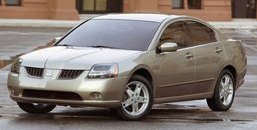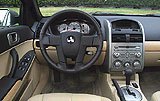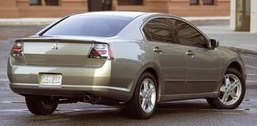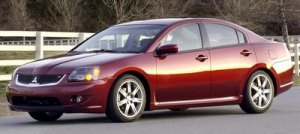|
Mitsubishi Galant
Debut: 2003
Maker: Mitsubishi
Predecessor: Galant (1996)
|
|
 As
the demand for mid-size sedans dropped sharply in Japan, Mitsubishi
designed
the new generation Galant primarily for the US market. That’s why it
becomes
much bigger and heavier than ever. Compare with the last generation, it
is a massive 22cm longer, 10cm wider, 5cm taller and rides on a
wheelbase
11.5cm longer ! if the old Galant was M size, the new Galant is
definitely
XL size. This also reflects on the scale: even the base four-cylinder
model
weighs as much as 1580kg, nearly 300kg up from the previous generation
! As
the demand for mid-size sedans dropped sharply in Japan, Mitsubishi
designed
the new generation Galant primarily for the US market. That’s why it
becomes
much bigger and heavier than ever. Compare with the last generation, it
is a massive 22cm longer, 10cm wider, 5cm taller and rides on a
wheelbase
11.5cm longer ! if the old Galant was M size, the new Galant is
definitely
XL size. This also reflects on the scale: even the base four-cylinder
model
weighs as much as 1580kg, nearly 300kg up from the previous generation
!
Does
it look bulkier? not really. Although I am not a fan of its new
corporate
grille, the new Galant looks pretty sleek and sporty, just like a
European
car. In fact, I suspect it copied the styling theme of the European
Ford
Mondeo, as the treatment of surfaces, edges and angles has a lot in
common.
Inside, it is another world - lots of space, lack of style. The cabin
offers
about the same space as its key rivals (Camry, Accord and Altima),
which
should satisfy the need of most families. However, the design of
dashboard
is so ugly. Especially is the center console, whose ugly shape and fake
titanium treatment simply look like a cheap Chinese-made CD-player.
Quality
is also poor, because hard plastics and cheap switch gears are used all
over the cabin.
 The
Galant is developed base on the Endeaver SUV platform. Its chassis is
100%
stiffer in torsion than the outgoing generation. Front suspension is
changed
from multi-link to MacPherson strut. Rear suspension remains to be
multi-link.
Two engines are available - the base engine is a 2.4-litre sohc
16-valve
with MIVEC 2-stage variable valve timing and lift. It produces 160hp
and
157lbft only because of a low 9.5:1 compression ratio. The flagship
engine
is an unusually large, 3.8-litre sohc 24-valve V6. It is enlarged from
the 3.5-litre being used by Diamante. This is an outdated design, still
uses cast-iron block and single-overhead camshaft. Moreover, stretching
to 3.8 litres does not benefit power efficiency, no wonder it pumps out
only 230 horsepower at a low 5250rpm. Inevitably, it relies on 250 lbft
of torque to please its lay-back-style driver. To disappoint keen
drivers
further, all Galants are equipped with 4-speed automatic. No manual
gearbox,
no 5-speed auto. The
Galant is developed base on the Endeaver SUV platform. Its chassis is
100%
stiffer in torsion than the outgoing generation. Front suspension is
changed
from multi-link to MacPherson strut. Rear suspension remains to be
multi-link.
Two engines are available - the base engine is a 2.4-litre sohc
16-valve
with MIVEC 2-stage variable valve timing and lift. It produces 160hp
and
157lbft only because of a low 9.5:1 compression ratio. The flagship
engine
is an unusually large, 3.8-litre sohc 24-valve V6. It is enlarged from
the 3.5-litre being used by Diamante. This is an outdated design, still
uses cast-iron block and single-overhead camshaft. Moreover, stretching
to 3.8 litres does not benefit power efficiency, no wonder it pumps out
only 230 horsepower at a low 5250rpm. Inevitably, it relies on 250 lbft
of torque to please its lay-back-style driver. To disappoint keen
drivers
further, all Galants are equipped with 4-speed automatic. No manual
gearbox,
no 5-speed auto.
 On
the road, the Galant 2.4ES performs just like an average family sedan.
It takes more than 9 seconds to accelerate to 60mph. Suspension setting
is comfort-biased, and its huge size discourage enthusiastic cornering.
On the highway and in high-speed bends, it goes quite competently,
thanks
to decent grip, braking, stability and steering feel. However, in tight
turns, it is hampered by its bulky size, soft suspensions and
understeer.
In return, you get a quiet and isolated ride. On
the road, the Galant 2.4ES performs just like an average family sedan.
It takes more than 9 seconds to accelerate to 60mph. Suspension setting
is comfort-biased, and its huge size discourage enthusiastic cornering.
On the highway and in high-speed bends, it goes quite competently,
thanks
to decent grip, braking, stability and steering feel. However, in tight
turns, it is hampered by its bulky size, soft suspensions and
understeer.
In return, you get a quiet and isolated ride.
The
flagship 3.8 GTZ is a little better in driver appeal. It accelerates to
60mph in less than 8 seconds, almost matching its lighter and more
efficient
rivals bar Nissan Altima. The V6 isn’t as refined as its rivals, but it
emits a sporty noise which doesn’t match its actual character at all.
Thicker
anti-roll bars, lower profile tires and stronger dampers improve its
handling
a little, but just a little. It doesn’t stand out of the crowd.
In
fact, the new Galant is a European car in look and American car in
nature.
Its big size and big engines please the American, but it also has the
flaws
troubling most American cars - cheap mechanicals, rough packaging and
lack
of driving fun. In an increasingly competitive segment, life won’t be
easy
for it. Mitsubishi hopes to build 100,000 units a year in Illinois,
USA,
where it will be assembled together with Endeavor.
|
| The
above report was last updated on 20 Dec
2003. All Rights Reserved. |
Galant Ralliart
|
 The Ralliart version of Galant was launched
in 2006 as the performance model of the range. It employs the 3.8-liter
MIVEC V6 from Eclipse, but produces slightly less power at 258 hp due
to more restricted exhaust. The engine is mated to a compulsory 5-speed
automatic transmission with manual mode. Car and Driver magazine found
it delivered surprising performance (0-60 mph in 6.1 seconds). Handling
was not bad either, thanks to stiff suspension setup and grippier
tires. Torque steer is reduced compared with Eclipse due to the extra
weight, but steer feel remains numb. The upgraded brakes still fail to
cope with the heavyweight machine. However, the worst aspect of the car
is still its dreadful look and cheap interior, which makes it the least
desirable among its rivals. The Ralliart version of Galant was launched
in 2006 as the performance model of the range. It employs the 3.8-liter
MIVEC V6 from Eclipse, but produces slightly less power at 258 hp due
to more restricted exhaust. The engine is mated to a compulsory 5-speed
automatic transmission with manual mode. Car and Driver magazine found
it delivered surprising performance (0-60 mph in 6.1 seconds). Handling
was not bad either, thanks to stiff suspension setup and grippier
tires. Torque steer is reduced compared with Eclipse due to the extra
weight, but steer feel remains numb. The upgraded brakes still fail to
cope with the heavyweight machine. However, the worst aspect of the car
is still its dreadful look and cheap interior, which makes it the least
desirable among its rivals.
|
| The
above report was last updated on 16 Aug
2009. All Rights Reserved. |
|
|
|
General remarks
|
Galant 2.4ES
|
Galant 3.8GTZ
|
Galant Ralliart
|
Layout
|
Front-engined, FWD
|
Front-engined, FWD
|
Front-engined, FWD |
Chassis
|
Steel monocoque
|
Steel monocoque |
Steel monocoque |
Body
|
Mainly steel
|
Mainly steel |
Mainly steel |
| Length / width / height |
4840 / 1840
/ 1470 mm |
4840 / 1840
/ 1470 mm
|
4850 / 1840 / 1478 mm
|
| Wheelbase |
2750 mm |
2750 mm
|
2750 mm
|
Engine
|
Inline-4
|
V6, 60-degree
|
V6, 60-degree |
Capacity
|
2378 cc
|
3828 cc |
3828 cc
|
Valve gears
|
SOHC 16 valves, VVT+L (MIVEC)
|
SOHC 24 valves
|
SOHC 24 valves, VVT+L (MIVEC)
|
Induction
|
-
|
-
|
-
|
Other engine features
|
-
|
-
|
-
|
Max power
|
160 hp |
230 hp |
258 hp
|
Max torque
|
157 lbft |
250 lbft |
258 lbft
|
Transmission
|
4-speed automatic
|
4-speed automatic |
5-speed automatic
|
Suspension layout
|
F: strut
R: multi-link
|
F: strut
R: multi-link |
F: strut
R: multi-link |
Suspension features
|
-
|
- |
-
|
Tyres front/rear
|
215/60HR16
|
215/55HR17
|
235/45WR18
|
Kerb weight
|
1580 kg
|
1655 kg
|
1690 kg
|
Top speed
|
123 mph (c)
|
140 mph (est)
|
-
|
0-60 mph (sec)
|
9.2*
|
6.8**
|
6.1*
|
0-100 mph (sec)
|
27.6*
|
-
|
15.9*
|
| Performance
tested by: |
*C&D,
**MT
|
|
|